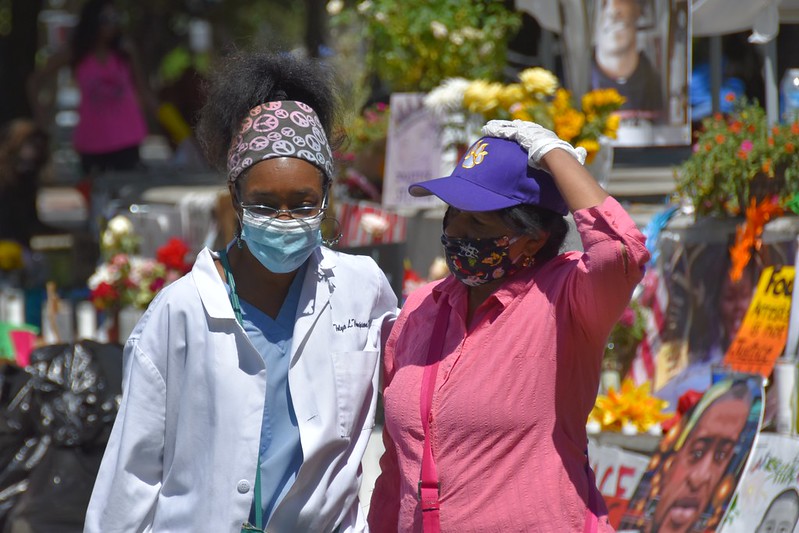 In recognition of Suicide Prevention Awareness Month, MARC is sharing the following alert from our colleagues at Prevention Institute. Their new suicide prevention toolkit resources, developed in partnership with the Center for Law and Social Policy (CLASP), feature comprehensive, multi-sector approaches that are aligned with strategies used by ACEs, trauma, and resilience (ATR) networks.
In recognition of Suicide Prevention Awareness Month, MARC is sharing the following alert from our colleagues at Prevention Institute. Their new suicide prevention toolkit resources, developed in partnership with the Center for Law and Social Policy (CLASP), feature comprehensive, multi-sector approaches that are aligned with strategies used by ACEs, trauma, and resilience (ATR) networks.
Prevention Institute's Suicide and ACEs Prevention multimedia resources include the 3-part MARC Podcast Series, and their new brief, Prioritizing Equity and Community Wellbeing in the Wake of Catastrophic Events: Trauma-Informed Systems and Long-Term Systems Change, features the work of Peace4Tarpon, one of the fourteen ATR networks that participated in the MARC 1.0 learning collaborative.
See below for a complete overview of the toolkit.
*************

New online modules focus on an equitable approach and rapid strategy development
Suicide is preventable. Unfortunately, over the past 16 months, younger adults, people of color, essential workers, and unpaid caregivers have reported increased thoughts of suicide. Emerging data shows a spike in suicide rates among Black Americans in certain locales and increased emergency department visits for suspected suicide attempts among young people. These and other populations are of growing concern as communities identify those at elevated risk of suicide and endeavor to counteract social isolation, financial stress, racism, and community trauma.
To support communities in planning a comprehensive, multi-sector response to these crises, Prevention Institute partnered with the Center for Law and Social Policy (CLASP) to develop a prevention toolkit.
The toolkit shares strategies for preventing suicide and trauma during catastrophic events like the COVID-19 pandemic, hurricanes, storms, or other disasters. It also includes online-learning modules; suicide-prevention planning interviews with agency leaders in Colorado and Santa Clara County, CA; a new social media video about Building Healing Communities; and an activity booklet that brings together concepts from Modules 1 through 4.
The newest modules support communities to
- Understand recent national trends and use interactive tools to identify local communities at elevated risk for suicide.
- Explore promising interventions addressing the unique needs of communities at high-risk.
- Understand how the CDC’s technical package and other tools and frameworks can support suicide-prevention efforts.
- Rapidly assess local fit and feasibility of best available evidence from CDC’s technical package during catastrophic events and beyond.
The toolkit also includes multimedia resources on social connection and trauma-informed systems.
On social connection
Rates of social isolation are soaring around the world, with profound impacts on health and wellbeing. As the world heals, how can we weave stronger connections among families, neighborhoods, and communities? We need community-led solutions focused on local talents and assets and rooted in community cultures and values. PI’s most recent short video, based on Healthy Places by Design’s Socially Connected Communities: Solutions for Social Isolation, shows how communities can improve social connection.
Watch the video and share it with your networks and on Facebook, Twitter, Instagram, and LinkedIn. If you want to talk health, you have to talk connection.
For more on the link between social connection and preventing suicide and Adverse Childhood Experiences, including examples of how organizations have fostered connection during the pandemic, check out Strengthening social connections to prevent suicide and adverse childhood experiences (ACEs): Actions and opportunities during the COVID-19 pandemic.
On systems change
By integrating trauma-informed practices to change public systems, local government agencies are addressing the needs of the community and essential workers in ways that can last beyond the pandemic. Check out PI’s latest brief, Prioritizing equity and community wellbeing in the wake of catastrophic events, to read about examples in Baltimore, Tarpon Springs, Houston, and San Francisco.
Prevention Institute’s multimedia resources focus on preventing trauma and suicide during catastrophic events, and include webinar recordings and other materials on supporting youth, addressing social isolation, advancing healing-centered systems, and prioritizing equity in COVID-19 recovery.
This work described above is funded by the Centers for Disease Control and Prevention. The toolkit is supported by Cooperative Agreement No. 6 NU38OT000305-02-03 from the Centers for Disease Control and Prevention (CDC). Its contents are solely the responsibility of the authors and do not necessarily represent the official views of the Department of Health and Human Services, or the CDC.
*Photo credit CC by sdttds